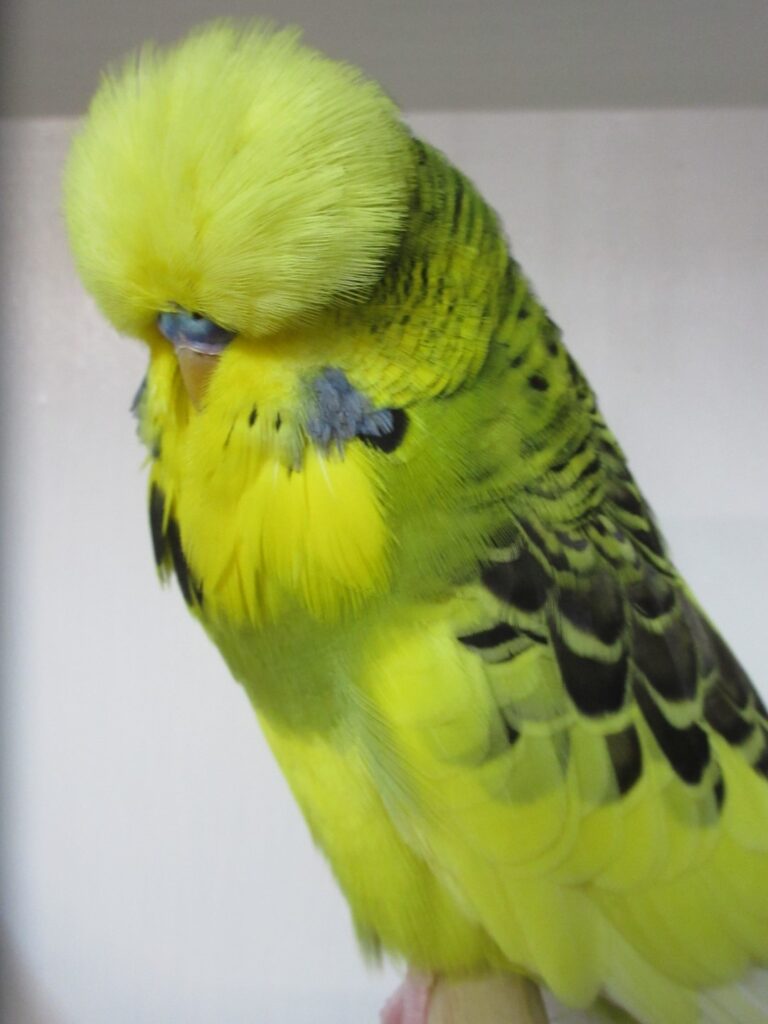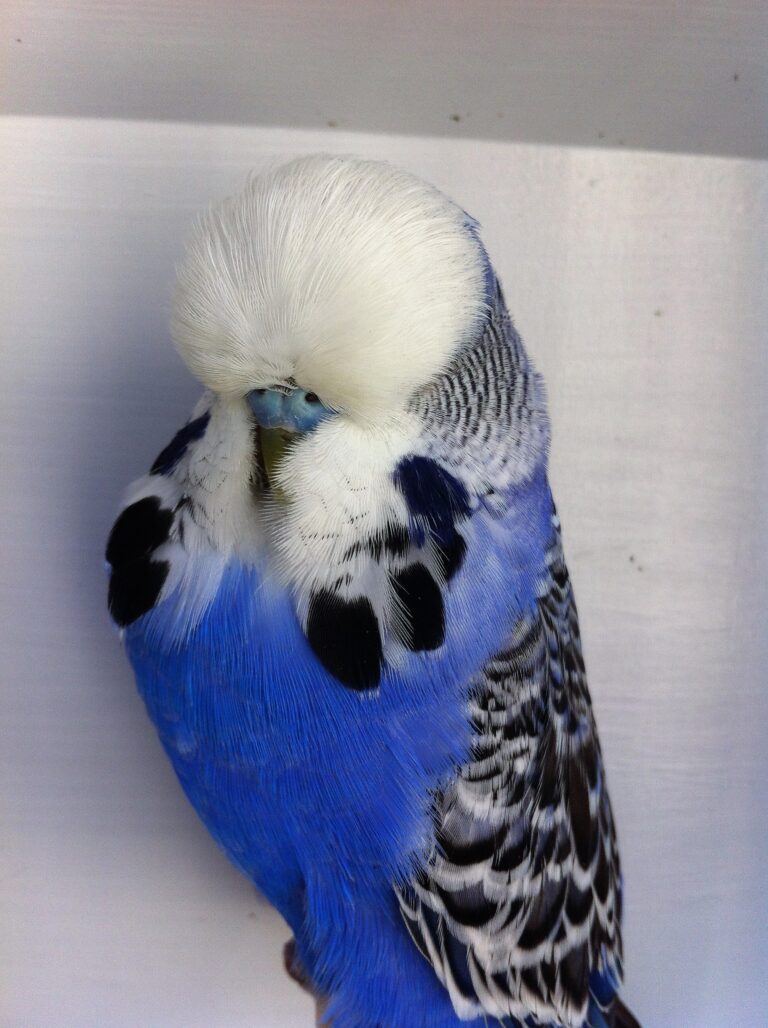North East Budgerigar Society
Linkage and the “Fallow Trick”
John Mulley, December 2021
Linkage and the “Fallow Trick” download
Option 1 for upgrading Type in recessive varieties is to outcross to quality Normals to produce split recessives. These split recessives receive 50% of their genetic content from the outcross. Mating these splits back to the recessive variety produces recessives in half the offspring. However, these chicks contain on average only 25% of the genetic content from the original outcross. Improvement is slow.
Option 2 for upgrading recessive varieties is to create splits from outcrossing, as above, and then mate split to split. Only 25% of the chicks will be recessives so one has to work twice as hard to breed the same number of recessives as Option 1. The reward is that the recessives from Option 2 incorporate 50% of the genetic content from the outcross rather than only the 25% achieved by Option 1. The remainder of these second-generation chicks will contain 50% of the genetic content from the outcross and two thirds of them will be splits, but which ones? That can only be determined by test mating.
Fallow is a recessive variety and tight linkage to the gene that mutated to Grey can be exploited to determine which of the second-generation chicks in Option 2 are splits. The best of these could be useful because they too will contain 50% of the outcross genetic content. They may have desirable features to offer our Fallow line or to other breeders interested in Fallows.
The “Fallow trick” only applies to the German Fallow, the same type of Fallow present in Australia. It makes use of the Grey mutation in either Green Series or Blue Series to determine which offspring of Split Fallow X Split Fallow crosses are definitively Split Fallows. The Grey mutation referred to is the common dominant Australian Grey mutation. There are in fact two Fallow tricks:
Trick 1
Step 1: Cross Fallow Greens or Fallow Blues with Single Factor Grey Greens or Single Factor Greys. (Known to be Single Factor Grey because one of their parents were either Green or Blue, or otherwise by virtue of having previously bred non-Grey Greens or non-Grey Blues). Offspring will all be Split Fallow with an expectation that half will visually carry the Grey mutation, generally referred to in lay terms as the Grey Factor, and the other half will not carry the Grey mutation. At least two such crosses are required so that one has birds for Step 2 that are not too closely related.
Step 2: From the chicks from Step 1 cross Split Fallow carrying Grey to Split Fallow without Grey, but not brother and sister. The expectation is that 25% of the chicks will be Green or Blue Fallows with 50% of their genetic background derived from an outcross. All non-Fallow non-Grey chicks will with certainty be Split Fallow, with 50% of their genetic background derived from an outcross. Non-Fallow chicks with Grey content are discarded.
Trick 2
Step 1: Cross Fallow Greens or Fallow Blues with Double Factor Grey Greens or Double Factor Greys. (Known to be Double Factor Grey because their previous matings never produced Greens or Blues without Grey, that is, not Grey Green or Grey). Offspring will all be Split Fallow, and all will visually carry the Grey mutation.
Step 2: From the chicks from Step 1, all of which are Split Fallow carrying Grey, cross to another outcross that is Green or Blue and not Grey Green of Grey. None of the Grey factor chicks will be Split Fallow but all the non-Grey Factor chicks (Greens and Blues) will be Split Fallow. They will carry a double injection of outcross genetic content, taking that content up to 75%.
Step 3: These 75%’ers can be mated directly to Fallows or if conscientious to Split Fallows with Grey Factor from Step 1 with an outcome as described for Step 2 of Trick 1.
The above is an expanded version of the basic procedure specific to Green Series that I saw some years ago published in the Australian BRASEA Bulletin that appeared without specifying an author. The above version is generic covering both the Green Series and the Blue Series in either Normal or Opaline and with or without Dark Factor or Violet. That is all you need to know for implementation, but if you are curious as to how it works then read on.
I have not seen any formal validation for either Trick 1 or Trick 2 as outlined above so I have provided an interpretation in the Appendix. If anyone knows of a similar or simpler explanation published elsewhere or knows of any reports of German Fallow Greys or German Fallow Grey Greens please let me know.
Linkage
Where does linkage come into it? Mendel’s second law of inheritance, independent assortment, states that alleles at two genes determining a pair of traits (in our case the Grey mutation at one gene locus and the Fallow mutation at another gene locus), are sorted independently from each other during the formation of sperm and eggs. Stated simply, alternative traits determined by different genes get an equal chance to occur together. But anyone in Australia who has attempted to produce Grey Green or Grey Fallows starting from Green or Blue Fallows knows that this is not always how this Mendelian law works, because you cannot breed Grey Green or Grey Fallows.
The most plausible explanation is that the gene mutated for Grey and the gene mutated for German Fallow are located extremely close together on the same pair of chromosomes. Under that circumstance alternative alleles at each gene are inherited together far more often than by chance. They are said to be linked, in genetic terminology, due to their physical proximity on the same chromosome. There are at least 26 pairs of chromosomes in budgerigars (they are hard to count due to many micro-chromosomes in birds) so genes for most monogenic traits determining budgerigar varieties are not linked on the same pair of chromosomes.
Assuming that the German Fallow mutation and the Grey mutation are indeed tightly linked on the same pair of homologous chromosomes then the German Fallow mutation at least in the Australian version is not on the same homologue of the chromosome pair as the Grey mutation. An improbable genetic crossover would be required to place the Fallow and Grey mutations onto the same homologue of the chromosome pair that carries them. Genetic crossover is improbable because the gene when mutated that expresses Grey and the gene when mutated that expresses German Fallow are located extremely close to each other.
According to the literature, the English and Scottish Fallows do occur in Grey Green and Grey forms. This is consistent with the fact that they and the German Fallow mutation involve three separate genes. The English and Scottish Fallows differ from the German Fallow in eye colour and presence and colour of the iris ring. When these three types of Fallow are inter-crossed the result is Normal non-Fallow chicks, proving that the three types of Fallow are caused by mutations at three different genes, probably on different chromosomes. The genes for English and Scottish Fallow are not tightly linked to the gene which when mutated gives Grey because these forms of the Fallow are reported in Grey Green and Grey.
Appendix
Notation used to validate Tricks 1 and 2 is defined as follows:
G+ refers to the dominant Grey mutation at gene locus 1 in either Greys or Grey Greens
G- refers to the absence of the dominant Grey mutation at gene locus 1 in Greens and Blues
f+ refers to the recessive Fallow mutation at gene locus 2
f- refers to the absence of the recessive Fallow mutation at gene locus 2
Due to tight genetic linkage we can treat the two gene loci as a single heritable block, in the same way that we treat the Lacewing Ino-Cinnamonwing combination. Thus, sperm or eggs are configured as follows:
G-f- Green or Blue without the Fallow mutation
G-f+ Green or Blue with the Fallow mutation
G+f- Grey Green or Grey without the Fallow mutation
G+f+ Grey Green or Grey with the Fallow mutation. In the absence of recombination creating this configuration it does not exist.
Trick 1 Step 1: Fallow Green or Blue G-f+/G-f+ X Single Factor Grey or Grey Green outcross G+f-/G-f- gives two types of chicks:
Genotype Phenotype Expectation Outcross content
G-f+/G+f- Grey Green or Grey Split Fallows 50% 50%
G-f+/G-f- Green or Blue Split Fallows 50% 50%
Step 2: Grey Green or Grey Split Fallows G-f+/G+f- X Green or Blue Split Fallows G-f+/G-f- gives:
Genotype Phenotype Expectation
G-f+/G-f+ Green or Blue Fallows 25% 50%
G-f+/G-f- Green or Blue Split Fallows 25% 50%
G+f-/G-f+ Grey Green or Grey Split Fallows 25% Discard
G+f-/G-f- Grey Green or Grey 25% Discard
All Greens and Blues will be Fallows or Split fallows with 50% of the outcross genetic content.
Trick 2 Step 1: Fallow Green or Blue G-f+/G-f+ X Double Factor Grey or Grey Green outcross G+f-/G+f-
Genotype Phenotype Expectation Outcross content
G-f+/G+f- Grey Green or Grey Split Fallows 100% 50%
Step 2: Grey Green or Grey Split Fallows G-f+/G+f- X Green or Blue outcross G-f-/G-f-
Genotype Phenotype Expectation Outcross content
G-f+/G-f- Green or Blue Split Fallows 50% 75%
G+f-/G-f- Grey Green or Grey 50% Discard
None of the Grey Greens or Greys will be Split Fallow but all the Greens and Blues will be Split Fallow with a double dose of the outcross genetic content. Mate to Fallows or go to Step 3.
Step 3: Green/Blue Split Fallows G-f+/G-f- (75%) X Grey Green/Grey Split Fallows G-f+/G+f- (50%)
Genotype Phenotype Expectation Outcross content
G-f+/G-f+ Green or Blue Fallows 25% 62.5%
G-f+/G+f- Grey Green or Grey Split Fallows 25% Discard
G-f-/G-f+ Green or Blue Split Fallows 25% 62.5%
G-f-/G+f- Grey Green or Grey 25% Discard
All the Greens and Blues will be Fallows or Split Fallows with 62.5% outcross genetic content.
Outcross genetic content is for both Tricks far exceeds the usual 25% as stated in the first paragraph.


